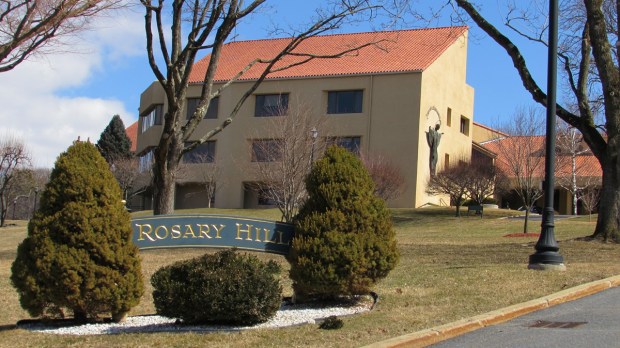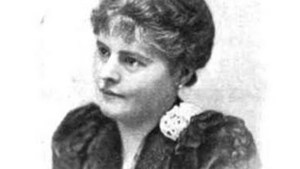I grew up in the Church of Jesus Christ of Latter-Day Saints in Alpine, Utah. At the beginning of high school my family moved to California. I completed high school in Los Angeles, and then moved to Davis for college. From high school through the years of college and beyond, I briefly attended a Presbyterian church, a non-denominational Christian Church, one Catholic Mass (for research purposes as part of an assignment in college), and a yoga studio. I was “spiritual but not religious,” and despite dabbling in different religions and spiritualities, I largely tried to ignore religion, except to make fun of it with friends.
By 2009 I was living in Washington, DC, completing my master’s degree in American History. In April of that year, I traveled to Italy for Easter to visit my boyfriend, who was stationed there. At the end of the trip, we went to St. Peter’s in Rome.
I had been there once before, during my brief time as a Presbyterian in high school, and wanted most of all to see the Pieta again. I remembered being amazed that stone could look like flowing fabric and delicate features. It held only artistic value in my memory – no religious significance.
When we arrived, my boyfriend dropped me off so that I could begin to look around while he found parking. Once I got inside, I went straight to the Pieta. Within a few moments I was, unexpectedly, in tears. I was not upset about anything, but I could not help crying. I was overwhelmed by the beauty of this woman’s face as she held her dead Son. And yet her face was peaceful, gentle, beautiful, not despairing. My boyfriend arrived some moments later and tried to figure out why I was in tears. I was able to stop crying as we walked around but could hardly explain myself. We looked at the rest of the art in St. Peter’s and left to get lunch. He asked me again, since I couldn’t stop talking about it, why that particular statue moved me so much. I said to him “I have no idea what I mean by this; the only thing that keeps running through my head is ‘That is what love looks like.’ That is love, carved in stone, made visible for everyone to see.”
That is what love looks like. That is love, carved in stone, made visible for everyone to see.
Fast forward one year, and instead of spending the Easter Octave in Italy with a boyfriend, I was celebrating the Octave as a single, newly baptized Catholic, at my new Parish, with my fellow-RCIA classmates and the Dominican friars who had guided me along the path of conversion and become true friends and teachers along the way. And I was more seriously contemplating the question that presses in on so many young Catholics: “What is my vocation? What sort of life is God calling me to, so that I can respond to this love He has poured into my life?”
The Dominican friars at my parish had welcomed me warmly to their House of Studies in Washington, DC, and so initially all I knew of Catholicism and religious life was essentially Dominican – like Blessed Diana, whom I am named for in religion, my heart embraced the Catholic Church and the Dominican Order in what seemed like a single movement.
When beginning my inquiry into Catholicism, I did not want to start RCIA, because I did not really want to become Catholic. The friar that I met first was extremely generous with his time and answered many of my varied questions. He encouraged me to begin RCIA and get to know the priests and people at the parish where he was a deacon. He also spoke to me about Christ’s Passion that day, the first of many times.
Over the months of RCIA I came to learn about the Church, and about the mad, boundless love of God for each of us. I learned, much to my surprise, that I was already loved immeasurably and eternally. I did not have to earn it or prove that I was worth it. I learned that the Cross was where Christ showed His love and I heard again and again, “You are worth the price of His Blood.” And so, I knew that I had to offer my love back to this God who had always loved me.
But how? I had always wanted to get married and have a family. Growing up Mormon, I never doubted that I would go down that road. I had gotten to know a lot of wonderful Catholic married couples and admired the way they lived their faith in the world. But I also knew that whatever form of life God called me to, I needed to live at the foot of the Cross. I did not know what that meant or looked like, but spending my life anywhere else seemed unthinkable.
I needed to live at the foot of the Cross. I did not know what that meant or looked like, but spending my life anywhere else seemed unthinkable.
My first year as a Catholic I became more and more involved in my parish, various young adult ministries and activities, and I participated in all that “Catholic DC” had to offer. It was a vibrant community and I had a great group of friends, a good job, a beautiful apartment, fantastic roommate, and a supportive parish “family.” Somehow, though, it all seemed like too many good things – like I was doing a lot of different things, but that my heart wanted simply one thing, THE one thing that I was meant for.
I was fairly sure that I would end up getting married but felt that I needed to look into religious life as an option – if for no other reason than that it was constantly on my mind and ended up the topic of most of my conversations. I also saw how happy the consecrated religious I knew were. I had experienced the generosity and freedom that came with celibate chastity, poverty, and obedience from the friars who had helped me so much for no other motive than their love of God and His Church. I had also met more Sisters since entering the Church and witnessed their joy, and their devotion to Christ, not just as their God, but as their Spouse.
So, near the end of 2011 I began to visit different religious communities and to more actively discern a religious vocation. I visited two communities of cloistered nuns, although I did not really want a cloistered life – it seemed simultaneously too lofty and too lonely. But my time there softened my heart to the cloister and let me see the beauty of that life. I also visited a teaching community of Sisters, and while I could see the goodness in it, I had no desire to teach. I mistakenly thought that if I wanted to be a Dominican, I had to teach or be in a cloister. So, while the desire to be a daughter of St. Dominic grew, so did my confusion as to how that might possibly come about. Perhaps I could be a lay Dominican, and then I could still get married and continue with my own plans?
I heard about the Dominican Sisters of Hawthorne from, once again, the Dominican friars. A student brother and I were both attending the wedding of a mutual friend, and I asked him about his summer assignment. He started telling me about their Dominican Sisters in New York who did not teach and were not cloistered, but instead combined the active and contemplative ideal of the Dominican Order in a unique way – they served the poor who were suffering from incurable cancer. They lived in the same homes as their guests and performed that single apostolate – providing free care, without government assistance, to anyone the Lord brought to them, for as long as the person needed it – regardless of whether they lived for three days or three years after their arrival.
Although it is not a canonical term, many of the friars described them as “semi-cloistered” – a hidden life but with an active apostolate. Both of my parents were physicians and so the idea of nursing did not frighten me; and death and dying were always acknowledged parts of life in my family, so the idea of working exclusively with the dying did not particularly frighten me either – in fact, it seemed to be a privilege that I could never be worthy of.
But what grabbed my interest was the life of the foundress – Mother Mary Alphonsa. She was the youngest daughter of Nathaniel Hawthorne, and a convert. As I read about her, I found myself drawn to her passion for caring for the sick, her complete dedication to the life she felt called to, her love of the Eucharist, her fervor for service and truth, and the fact that once she became a Catholic her life seemed to be “all or nothing” for the Lord.
I could not ignore the fact that Mother Alphonsa saw her life and the life of her Sisters as living at the foot of the Cross …
After reading about her and the Hawthorne Dominican community, I thought to myself, “I could never do this, but if I was going to be a Sister, I would want to be one of these Sisters.” I could not ignore the fact that Mother Alphonsa saw her life and the life of her Sisters as living at the foot of the Cross, that she saw the apostolate as service to the crucified and dying Christ in the form of the cancerous poor. But I felt intimidated by the idea of community life, and I still wanted so much to be a wife and a mother. I thought surely there was a way to find life at the foot of the Cross outside of a religious community. But, in order to be thorough in my discernment, I went and visited the Hawthorne Dominican Sisters – in part so that I could cross them off my list.
I’ll never forget my first Sunday Mass at Rosary Hill, our Motherhouse, in the hills of Westchester County. I had already spent a few days with the Sisters and was surprised at how easy it was to be around them. One of my difficulties with discerning religious life had been that I found Sisters simultaneously intriguing and terrifying. I was always worried about doing or saying the wrong thing and was not sure I could be myself around them. With the Sisters at Hawthorne, those fears quickly eased or disappeared. I found the apostolate challenging but incredibly joyful, and I even found the fact that the life was clearly challenging and strenuous – physically and spiritually – very attractive. It seemed like an invitation to live something real and meaningful.
At that first Sunday Mass I saw only Christ, everywhere.
At that first Sunday Mass I saw only Christ, everywhere. I was looking at the Sisters, the patients who could come to Mass, the priest, the Eucharist, and I was overwhelmed by the realization that this was truly a life filled with Christ, with His presence and His grace. It was the same Christ in the Eucharist, in the priest, in the Sisters consecrated to Him, in the patients whom He loved so much that He brought them to this free home in order to end their days in peace, comfort and joy; and come to know Him personally – whether they ever had before or not.
I left knowing that this community was special, whether it would ever be mine or not. I loved the balance between the apostolate and prayer, I loved their obvious devotion to the Eucharist as the heart and center of their life – Mass to begin each day, communal prayer with the liturgy of the hours, daily Eucharistic adoration in the morning and afternoon and all day on Fridays – and I loved how each Sister seemed to be herself.
After another year and a half, and many ups and downs, I applied for acceptance to the community, was accepted, and began my time of postulancy on October 7, 2013. My entrance was not quite “happily ever after,” though, and I continued to struggle with whether I was called to this life or was just trying to force something that I thought I should do. One day I was throwing myself a particularly elaborate pity party during Adoration and I heard in my heart, “You just need to learn what love looks like.” Memories of that trip to Rome years before came back to me. I realized that in order to accept my vocation, I had to let go of all my ideas of what I thought love should look like for my life – whether it was a true good, like a holy marriage, or the lies I had absorbed for so many years from the culture. I had to look at Our Lady and her Crucified Son to learn what love looks like.
And so for the past eight years I have had the privilege of learning what love looks like in all the hidden, ordinary glory of daily life in community, apostolate, prayer and study. Sometimes love looks spectacular – the baptism of a patient weeks or hours before they die, the special trust and gratitude of a loving family, becoming the family for a guest who has no one at all, times of great joy and friendship in community. Most of the time, however, love takes on the appearance of silent, ordinary moments of patience with myself or my Sisters, and it is often reflected in their daily mercy towards me. Love also looks like the willingness to get up early to take care of someone every day, whether you feel like it or not, or showing up in the chapel on time when you would prefer 10 more minutes to yourself. It looks like the privilege of sitting with someone as they hurt or are afraid or lonely at 2 o’clock in the morning, holding their hand and praying the Rosary as they die – surrounding them with the love of Christ and the protection of Our Lady as they take their last breath and step into eternity.
And most recently, love looks like the grace and privilege of accepting Jesus’ wedding ring from the friar who first taught me about the love of Christ. It looks like becoming His forever — as a Bride of Christ, a daughter of St. Dominic and Mother Mary Alphonsa, and a Sister to my Sisters here, as I continue to learn what love looks like.
~
If you would like to know more about the Dominican Sisters of Hawthorne, please visit our website www.hawthorne-dominicans.org , or call 845-745-1319.



